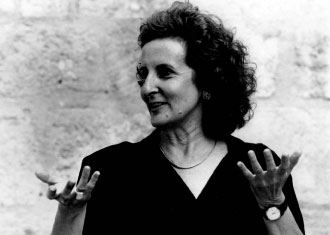Trisha
Brown

Benois de la Danse laureate
Founding her own company in 1970, Brown explored the terrain of her adoptive SoHo, creating her early dances for alternative spaces including roof tops and walls, and flirting with gravity — alternately using it and defying it. Her Man Walking Down the Side of a Building foreshadowed not only her own innovative use of flying in her 1998 production of Monteverdi▓s L▓Orfeo, but also much of the work of choreographers and theatrical directors who still seek unusual and startling contexts for the human body. She soon began exploring her complex movement ideas over the course of several dances, working in cycles. In 1983 she added the Robert Rauschenberg/Laurie Anderson collaboration, Set and Reset to her first fully developed cycle of work, Unstable Molecular Structures, establishing the fluid yet unpredictably geometric style that remains a hallmark of her work. The relentlessly athletic Valiant Series followed, perhaps epitomized by the powerful Newark in which she pushed her dancers to their physical limits and explored gender-specific movement for the first time. Next came the elegant and mysterious Back to Zero cycle, in which Brown pulled back from external virtuosity to investigate unconscious movement as seen in the classic For M. G. : The Movie.
Inspired by her experience choreographing a production of the opera, Carmen with director Lina Wertmüller, Brown turned her attention to classical music with the goal of directing her own opera production. In 1998 her production of Monteverdi▓s L▓Orfeo premiered in Brussels and later played to sold-out houses in London, Paris, Aix-en-Provence, and New York. Brown joined with two new collaborators, visual artist Terry Winters and composer Dave Douglas, to create a trilogy danced to the sounds and structures of today▓s new jazz music. Working with celebrated lighting designer Jennifer Tipton, the team has produced an evening-long choreography full of sensuousness and marked by an unmistakable modernity. Completed in 2000, El Trilogy clearly heralds a new direction for a new century.
In 2001, Brown returned to the opera stage to create a new production of Salvatore Sciarrino's Luci Mie Traditrici. Based on the story of Count Carlo Gesualdo, early 17th century composer, the opera is an account of love, betrayal, and murder. Brown's staged production of Franz Schubert's Winterreise for British baritone Simon Keenlyside and three dancers premiered in December 2002 as part of Lincoln Center's New Vision series. The mysterious Geometry of Quiet, also received its American premiere in December 2002. December 2003 marked the World Premiere of Brown▓s latest piece, PRESENT TENSE, in Cannes. Trisha Brown is the first woman choreographer to receive the coveted MacArthur Foundation Fellowship and has been awarded many other honors including Brandeis University▓s Creative Arts Medal in Dance, two John Simon Guggenheim Fellowships, and most recently, the National Medal of Arts in 2003. In 1988 she was named a Chevalier dans l▓Ordre des Arts et des Lettres by the government of France. She was elevated to Officier in 2000 and then to the level of Commandeur in December 2004. Ms. Brown▓s Set & Reset is currently included in the baccalaureate curriculum for French students pursuing dance studies. She was a 1994 recipient of the Samuel H. Scripps American Dance Festival Award, has been named a Veuve Clicquot Grand Dame, and, at the invitation of President Bill Clinton, served on the National Council on the Arts from 1994 to 1997. In 1999 Brown received the New York State Governor▓s Arts Award. She has received numerous honorary doctorates and is an Honorary Member of the American Academy of Arts and Letters.
Gallery
